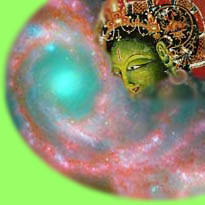|
The Short Commentary on the Tantra of Twenty-one Homages to Tārā called “The Treasure Vase of by Thupten Shedrub Gyatso. |
The Fearless Swift Lady |
|||||||||||||||||||||
|
1
|
namas tāre ture vīre kṣaṇair dyuti-nibhêkṣaṇe | trailokya-nātha-vaktrābja-vikasat-kesarôdbhave || namaḥ (n/V) – adoration, homage; tāre (f/V) – O Tārā; ture (f/V) – quick, willing, prompt; vīre (f/V) – victor, heroine; kṣaṇaiḥ (m, I/pl) – instant, twinkling of an eye; dyuti (f) – splendour, brightness, majesty; nibha – like, similar; īkṣane (f/V) – view, sight, look, glance; trailokya (n) – of the three worlds; nātha (n)– protector, lord; vaktrābja (n) – lotus face; vikasat – opening, shining, bright; kesara – [n] hair, [m] flower; udbhave (f/V) – produced, coming from. Homage to mother Tārā, swift and fearless, Your eyes are like flashing lightning. Born from the blossoming stamens Of the lotus face of the Lord of Three Worlds. The first praise is to Myurma Palmo, the “Fearless Swift Lady”. Here we pay homage to the lady of activity who liberates beings from the temporal and perennial sufferings of saṃsāra1. She is called “Swift Lady” because her impartial compassion2 benefits beings without even an instant’s delay. She is the “Fearless Lady”, because she has the unhindered power to subdue demons, as well as the afflictions of beings. She protects beings from all fears. Her wisdom eyes move like the flash of lightning as she fully cognizes all phenomena. The lady endowed with omniscience, compassion, power, and activity was born from “the teardrops of the stamen-like eyes of the fully blossomed lotus-like face of Avalokiteśvara3, the Savior of Three Worlds”. The three worlds are the sub-terrestrial, terrestrial and celestial realms, (the worlds of nāgas4, humans, and gods, respectively). Tārā is seductive, and has the youthfulness of the rising sun, and a semi-wrathful smile. Her right hand is in the boon-giving mūdra5, and her left hand holds a blue lotus upon which is a right-turning conch. This symbolizes her mastery of the two truths6 and bodhicitta7: in this world, and in the god realm8. The outer meaning of the praise literally praises the nirmāṇakāya aspect of the Noble Lady. In the inner aspect of the praise, if not taken literally, her sambhogakāya and dharmakāya aspects are praised. The “Savior of the Three Worlds” is the dharmakāya, and its manifestation is the rūpakāya, or “form body,” (which is composed of the sambhogakāya and nirmāṇakāya).
1 saṃsāra skt ~ Cyclic existence, the endless cycle of birth, death and rebirth characterized by suffering and dominated by the three poisons: ignorance, desire and hatred. 2 compassion (karuṇā skt) ~ Sensitivity to the sufferings experienced by sentient beings, coupled with a desire to help them overcome suffering and its causes. 3 Avalokiteśvara skt (Chenrezig) ~The Buddha of compassion. 4 nāga skt ~ A snake-like being living in the depths of water or underground. Although they have miraculous powers, they are classified as belonging to the lower realm. 5 mudra skt ~ A gesture that has specific meaning used in Tantric practice as a support. 6 two truths (satyadvaya skt) ~ The absolute (paramārtha skt) and relative (saṃvṛtti skt) truth (satya skt). 7 bodhicitta skt ~ The mind of enlightenment. The altruistic intention to become enlightened in order to benefit others 8 god realm ~ One of the six realms of cyclic existence, characterized by seemingly unending pleasure and leisure. |
|||||||||||||||||||||
|
|

